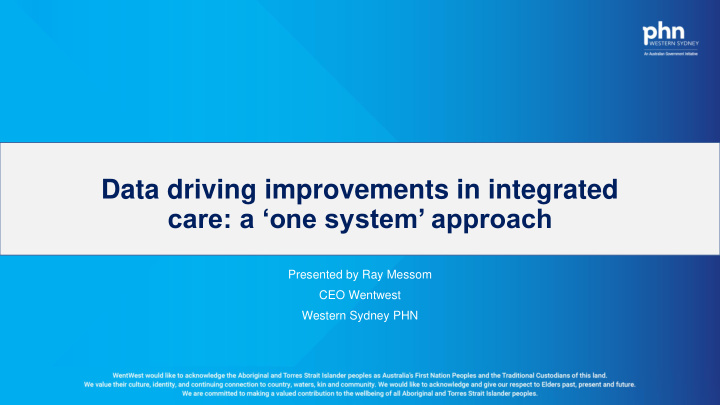



Data driving improvements in integrated care: a ‘one system’ approach Presented by Ray Messom CEO Wentwest Western Sydney PHN
Consumer 2
Healthcare is data-driven, but human to the core. Data drives outcomes. But it’s the people behind the data that have the power to make a difference.
Plumbing (Lumos) Finishings (Insights) The Dream (Value based, patient centred care) 4
Plumbing (Lumos) Data is the lifeblood of an insight driven health system 5
Lumos • Australia’s first linked Primary Care Data Asset. • Includes patient’s entire health journey across primary, ambulatory and acute care establishing • The Pilot Project • By April 2020: • 40 practices • 150 practices • 4 NSW PHNs • 10 NSW PHNs • 400,000 patients • 1,000,000 patients
Partnership with all 10 NSW PHNs Extensive stakeholder engagement: MoH, LHDs, PHNs, GPs, ACI, Health Consumers NSW, RACGP, AMA Automated and secure data extraction and data transfer Encoding at source for Privacy Preserving Record Linkage – this means no patient identifiers leave a practice Ethics application submitted to the NSW Population & Health Services Research Ethics Ethics Committee to support scale up
Finishings (Insights) Data provides insights to forge the path forward 8
Robust evidence is paramount RISK STRATIFICATION PROPENSITY SCORE MATCHING DATA MINING STATISTICAL AND CAUSAL MODELLING DYNAMIC SIMULATION MODELLING
Risk Stratification: Which patients should integrated care target? Risk Model Engine Patient Risk Scores Patient Data General practice Risk model that classifies Enables accurate data patients into groups identification of patients Hospital data based on their risk of suitable for specific Mortality data hospitalisation in the next Integrated Care Programs 12 months Helps achieve the best enrolment strategy for Integrated Care programs RISK STRATIFICATION
Propensity score matching to demonstrate outcomes Propensity score matching is a technique used to construct equivalent comparison cohorts to evaluate whether an intervention has truly been beneficial in achieving outcomes. Individuals are matched to create two groups of people that are equally likely to have been enrolled in the intervention. PROPENSITY SCORE MATCHING
Data mining to predict the likelihood of a patient being admitted post discharge Data mining is exploring and discovering anomalies, patterns and correlations within big data which can lead to predicting outcomes: We are utilising data mining techniques to identify patterns in patient journeys that inform how care can be better delivered. Anomalies Patterns Correlations A GP visit within two weeks of an admitted patient episode results in a 60% reduction in an unplanned hospitalisation within the next 3 months GP visit AP visit ED visit GP visit GP visit Admitted Patient Admitted Patient Hospitalisation Hospitalisation DATA MINING
What is the healthcare utilisation and cost of patients being diagnosed with Type II diabetes at a general practice compared in hospital? Fragmentation Statistical Modelling Risk of Hospitalisation 120% for patients with an unrecognised diagnosis By linking primary and The Australian (i.e. diagnosed in hospital) acute care data, the risk healthcare system is of unrecognised siloed and data is not diabetes (i.e. diagnosed usually shared between at hospital but not in the hospital and GP. primary care) is 55% for patients diagnosed in established using a primary care with diabetes logistic model. STATISTICAL AND CAUSAL MODELLING
We can change patient’s health trajectories 1.4 times more likely Admitted Diagnosis episode Admitted at the episode hospital GP visit ED presentation Patient pathway Early diagnosis GP visit GP visit GP visit at the GP DYNAMIC SIMULATION MODELLING
Early intervention and diagnosis is better more sustainable care The model predicts the cost savings for whole-of-NSW over 8 years would be: Approx. $3.2 billion Total cost post diagnosis in hospital: ~$50k For an individual Total cost post diagnosis in GP: ~$20k
The Dream Value based, patient centred care We think and act as ‘one system’ 16
Key PHN role in the system Strategic Integrated 1 Commissioning Care 2 4 3 Primary Care Data, Analytics Transformation and eHealth
Patient Centred Medical Home
Patient Centred Medical Home – 10 Building Blocks Bodenheimer et al.
Emerging analysis: Difference in service provision across practices Potential impacts of improved access to high quality primary care GP Encounter Hospitalisation Emergency presentation • Unadjusted for patient risk, correlation not causation and numerous compounding factors could be at play.
What’s next? Collaborative Commissioning Thinking as ‘one western Sydney health system’ Pursuing value and outcomes through planning, co-design, procurement, performance support and management, monitoring and evaluation 21
Consumer 22
Data driving improvements in integrated care: a ‘one system’ approach Thank You Presented by Ray Messom CEO Wentwest WentWest (Western Sydney PHN)
Recommend
More recommend